

1 What are the principal properties of a permanent magnet?
Permanent magnets are identified by the following principal magnetic properties:
Maximum energy product (BH)max, in unit of GOe (gauss-oersteds, CGS unit) or J/m3 (joules per cubic meter, SI unit), 1J/m3=4π×10 GOe, Remanence Br, in unit of Gs or T, Coercivity HcB, in unit of Oe or A/m, Intrinsic coercivity HcJ, in unit of Oe or A/m. Other magnetic properties of permanent magnets are: Curie temperature (Tc), operable temperature (Tw), temperature coefficient of remanence (α(Br)), temperature coefficient of intrinsic coercivity (β(HcJ)), recoil permeability (μrec), demagnetization curve square degree (Hk/HcJ),.
In addition to magnetic properties, physical properties of permanent magnets include density, electrical conductivity, thermal conductivity, thermal expansion coefficient, etc. Mechanical properties include Vickers hardness, Young’s modules, compression strength,tensile strength, impact resistance and so on. Besides, one important performance indicator of permanent magnets is the surface state and its corrosion resistance.
2 What is magnetic field strength?
In 1820, H. C. Oersted discovered that a current-carrying wire could deflect nearby magnetic needle, revealing the basic relationship between electricity and magnetism. And then the electromagnetics were born. Practice has shown that the strength of the magnetic field generated by the infinitely long wire passing through the current is proportional to the magnitude of the current and inversely proportional to the distance from the wire. The magnetic field strength is usually expressed in H. The unit of magnetic field strength in SI unit system is A/m, and 1 A/m is the magnetic field strength of an infinitely long conductor carrying 1 amp of current at a distance of 1/(2π) from the conductor. In CGS unit system (cm-gram-second), the unit of magnetic field strength is 1Oe (Oersted). To commemorate Oersted's contribution to electromagnetism, the magnetic field strength of an infinitely long wire carrying 1 amp of current at a distance of 0.2 cm is defined as 1Oe (Oersted), 1Oe=1/(4π)103A/m.
3 What is magnetic polarization (J),magnetization(M) and the difference between them?
Modern magnetism have shown that all magnetic phenomena originate from current, rather than the ‘magnetic charge’ that was originally imagined. Magnetic materials are no exception. The magnetic phenomenon originates from the movement of basic particles in the atoms inside the material. The collective effect causes the material to exhibit various macroscopic magnetic properties. Based on the molecular current assumption, a closed annular microcurrent (molecular current) is equivalent to a small magnetic needle, the magnetic dipole.
Defining the maximum torque generated by unit magnetic fieldto a magnetic dipole of materials under vacuum is the magnetic dipole moment pm, and the vector sum of the magnetic dipole moments per unit volume of material is the magnetic polarization J with unit T (Tesla, SI unit). In the CGS unit system, the unit of J is Gs, 1T = 104Gs.
Defining the magnetic moment of a magnetic dipole is current I multiplied by current loop area a, m=Ia. And its unit in the SI unit system is A?m2. The vector sum of the magnetic moments per unit volume of material is the magnetization M. The unit of M is A/m in the SI unit system same as magnetic field strength and Gs in the CGS unit system.
The relationship between magnetic dipole moment and magnetic moment is pm=μ0m, where μ0 is vacuum permeability. And the relationship between J and M is J=μ0M, where μ0=4π×10-7H/m in SI unit system and μ0=1 in CGS unit system. the magnetic polarization is equal to the value of the magnetization in CGS unit system.
4 What is the magnetic induction (B), magnetic flux density (B) and the relationship between B, H,J and M?
Both theory and practice have shown that when a magnetic field H is applied to any medium, the magnetic field strength inside the medium is not equal to H, but is expressed as the sum of H and the magnetic polarization J of the medium. The magnetic field H can be provided by an external current or an external permanent magnet. And it can also be provided by the permanent magnet medium itself which is called Demagnetizing field---see ‘What is demagnetizing field?’ Since the magnetic field strength inside the medium is expressed by the induction of the magnetic field H through the medium, it is called the magnetic induction and recorded as B to distinguish from H:
B= μ0H +J= μ0(H+ M) (SI) (1)
B= H +4πM(CGS)
The unit of M is A/m in SI unit system same as magnetic field strength and Gs in CGS unit system(1T=104Gs).
For non-magnetic media such as air, water, copper, aluminum, etc., the magnetic polarization strength J or the magnetization M are almost equal to 0, so the magnetic induction B of the medium is completely from the magnetic field strength H. And in CGS unit system, magnetic induction is equal to the value of magnetic field strength H in different units.
Since magnetic phenomenon can be visually represented by magnetic lines of force, magnetic induction B can be defined as the areal density of magnetic flux, magnetic flux density. magnetic induction and magnetic flux density are conceptually equivalent.
5 What is the demagnetization curve of a permanent magnet?
For ferromagnetic materials, the response of magnetic induction B to magnetic field H is usually hysteretic. By plotting B against H (usually in rectangular coordinates) a close loop will be generated which is called a hysteresis loop. There are infinite hysteresis loops for a permanent magnet according to the magnitude of the external applied fields. Generally, we designate the possibly maximum hysteresis loop as the major hysteresis loop of a permanent magnet. Fig.1a shows the typical major hysteresis loops of sintered Nd-Fe-B permanent magnet. The relationship of B-H is known as the standard curve, and that of J-H is known as the intrinsic curve. The two curves are correlated at every point by equation (1). i.e. we can derive one from the other by equation (1).
The demagnetization curve is the second (or equally the fourth) quadrant of a major hysteresis loop. The demagnetization curves for the typical Nd-Fe-B magnet are shown in Fig.1b, , one of which is B-H curve(or B demagnetization curve), the other is J-H curve(or J demagnetization curve).
The B-H curve is used for magnetic circuit design to represents the energy output of the magnet on calculating the energy in air gap. the intrinsic curve J-H is used to determine how the external field changes the intrinsic characteristics of magnet. When permanent magnet meet with an external field, the force or torque on the magnet will be given by the interaction between the intrinsic polarization and the external field.
The operating point of permanent magnet is a point on B-H demagnetization curve defined by the coordinates (Hd, Bd), for example point D, shown in Fig.1c. The operating line for a given permanent magnet circuit is the straight line OP passing through the origin and the operating point D on the B-H demagnetization curve with a slope of Bd/Hd. The ratio of the magnetic induction to demagnetizing force Bd/Hd is also known as magnetic permeance coefficient of the magnet or circuit. Then,the operating line is also called permeance coefficient line.
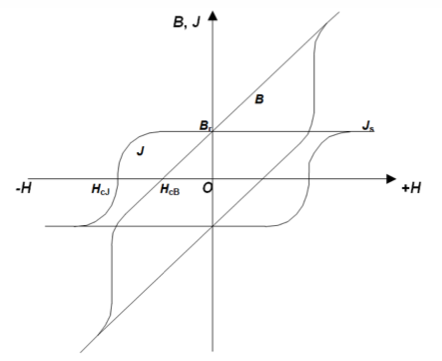
(a)
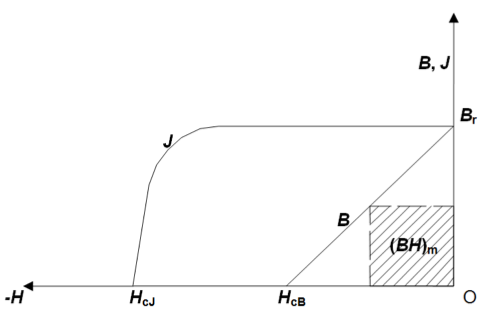
(b)
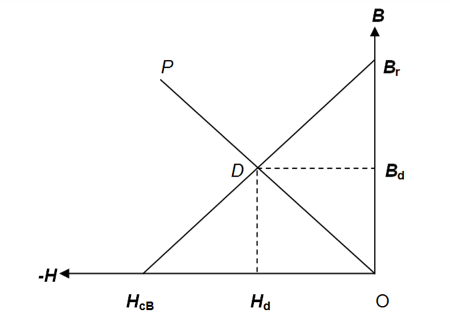
(c)
Fig.1: Typical hysteresis loops (a) and demagnetization curves (b) of a permanent magnet. The operating point and operating line of a permanent magnet are illustrated in (c).
6 What is the remanence of a permanent magnet? Why is the magnetic polarization J and the magnetic induction B of any measurement point on the demagnetization curve of the permanent magnet necessarily smaller than the magnetic residual Jr and Br values?
A typical characteristic of the B and H response hysteresis of permanent magnet materials is that the magnetic polarization J and the internal magnetic induction B will not disappear but maintain certain values when the material is magnetized to saturation under external magnetic field in the closed circuit and then returned to the state where the external magnetic field is cancelled. The values are called the residual magnetic polarization Jr and the residual magnetic induction Br of the material. According to the relation (1), when magnetic field H = 0, Jr = Br, and both the value and unit of Jr and Br are the same, therefore, they are collectively described as remanence.
When magnetic field H ≤ 0, equation (1) gives J≤ B and there are two demagnetization curve(J-H and B-H). , the magnetic polarization J of the permanent magnetic material decrease from Jr as the absolute value of the reverse magnetic field H increase from 0, which denotes J≤Jr. For modern hard ferrite and rare earth permanent magnetic materials, the J demagnetization curve display as a straight line with positive slope in the region where the absolute value of H is low. Accordingly, B decrease from the maximum value Br = Jr to 0, then becomes negative; if the B = 0 point is still in the straight line section, B demagnetization curve is very close to a straight line but with slope k >μ0.
7 What is the coercivity of a permanent magnet? What is the intrinsic coercivity of a permanent magnet?
On the B demagnetization curve of the magnetic material, the magnetic induction B = 0 when the absolute value of the reverse magnetic field H increases to a certain value HcB. The absolute value of the reverse magnetic field H is called the coercivity HcB of the material. And when H = -HcB, the magnets do not exhibit magnetic flux, so the coercivity HcB can characterize the ability of the permanent magnetic materials to resist the external reverse magnetic field or other demagnetization effects. The coercivity HcB is an important parameter in magnetic circuit design.
It is worth noting that coercive force HcB is always smaller than remanence Br/μ0. it can be seen from equation (1) that B = 0 when H= -HcB, which leads to μ0HcB=J. Q6 has shown that the value of the magnetic polarization at any point on the J demagnetization curve is always smaller than the remanence Jr. Therefore, HcB<Jr/μ0 = Br/μ0. In CGS unit system, the value is HcB<Jr = Br. For example, when a magnet has a remanence Br=12.3 kGs, then its coercivity HcB cannot be greater than 12.3 kOe. In other words, remanence Jr is the theoretical upper limit of coercive force HcB.
When reverse magnetic field H =-HcB, there is B = 0 and the magnet does not show magnetic flux, but magnetic polarization J of the magnet maintain a considerable value in the initial magnetization direction, that is, the vector sum of microscopic magnetic dipole moment inside the magnet is not 0. Therefore, H =-HcB does not correspond to the state in which the macroscopic magnetization inside the magnet disappears. When the absolute value of reverse magnetic field H further increases to certain value HcJ, the magnetic polarization of decrease to J = 0, i.e. the vector sum of microscopic magnetic dipole moment inside the magnet is 0. the absolute value of reverse magnetic field H is described as intrinsic coercive force HcJ of the material.
The intrinsic coercivity HcJ is a very important physical parameter of permanent magnet materials. For a magnet with HcJ>>HcB , , the magnetic polarization J remains in the original direction even when absolute value of the reverse magnetic field H is greater than HcB but less than HcJ that the induction B is already reversed. the B of magnet can still return to the original direction due to the retention of J After the magnetic field H is cancelled. In other words, as long as the reverse magnetic field H has not reached HcJ, the permanent magnet material has not been completely demagnetized. Therefore, the intrinsic coercive force HcJ is a primary indicator of permanent magnet material to maintain its original polarization against external reverse magnetic field or other demagnetizing effect.
The unit of coercivity HcB and intrinsic coercivity HcJ are the same as the unit of magnetic field strengh.
8 What is the maximum energy product ‘(BH)max’of a permanent magnet?
On the demagnetization curve of the permanent magnet (second quadrant of B-H curve), different coordinates correspond to different working states of the magnet. Bm and Hm (absolute values of horizontal and vertical coordinate) corresponding to one point on the B demagnetization curve represent the correlated magnetic induction and the magnitude of the magnetic field inside the magnet (the direction of the magnetic field is opposite to the direction of magnetic induction). The product (BmHm) represents the ability of the magnet to output power. It is equivalent to the magnetic energy stored by the magnet per unit volume, which is called as magnetic energy product. At the Br point and the HcB point of B demagnetization curve, there is (BmHm)=0, indicating that the magnet's ability to output power is 0, i.e., the magnetic energy product is 0. The magnet with maximum value of (BmHm) indicate that the magnet has the greatest ability to output power. The maximum value of (BmHm) is called as maximum magnetic energy product of the magnet, or simply the magnetic energy product, denoted as (BH)max or (BH)m. Therefore, it is generally preferred for a magnet in magnetic circuit to operate with maximum energy product. Due to Br≥μ0HcB, maximum energy product(BH)max ≤ Br2/4μ0.
The unit of energy product is J/m3 in SI unit system and GOe in CGS unit system (4π×10GOe = 1 J/m3).
9 What is the curie temperature (Tc), and what is the operable temperature Tw of the magnet? What is the relationship between the two?
With the increasing of temperature, as the thermal vibration of the particles inside the material is intensifying, the microscopic orientation of magnetic dipole is gradually disturbed. Macroscopically, the magnetic polarization J of material decreases as temperature increases, and there exists a transition temperature above which the magnetic polarization J is reduced to 0. Then, the material performs as nonmagnetic similar to air. The transition temperature is defined as the Curie temperature Tc. The Curie temperature is an intrinsic property of magnetic material. It is only related to the chemistry of the magnetic material, rather than the microstructures.
At a certain temperature, the magnetic performance of single permanent magnet or magnetic circuit composed of permanent magnets is considerably lower (e.g. a confined limit of 5%) than those at room temperature. The temperature is referred to as the operable temperature Tw. Since this reduction limit depends on the application of the magnet, the so-called operable temperature Tw of the magnet is not a material intrinsic parameter. That is, the operable temperature is varied on application conditions such as geometric factors or magnetic circuit structure- for the same magnet.
the Curie temperature Tc of the magnetic material represents the theoretical operating temperature limitation. In fact, the actual operable temperature Tw is much lower than Tc. For example, ternary Nd-Fe-B magnet has a Tc of 312℃, while its actual operable temperature Tw is typically less than 100℃. By adding heavy rare earth and other metal elements such as Co and Ga into alloy, the Curie temperature Tc and the operable temperature Tw of Nd-Fe-B magnet can be remarkably improved. It is worth noticing that the operable temperature Tw is not only related to the Tc, but also related to the magnetic properties such as HcJ and the role of magnet in magnetic circuit. bonded magnet, which is a composite system of magnetic powder and binder, its temperature resistanceof binder may also become a constraint of Tw.
10 What is the demagnetizing field?How to determine the demagnetizing factor and the operating point of a permanent magnet?
When permanent magnet provides magnetic induction B, it also applies an internal magnetic field Hd opposite to intrinsic magnetization M. The magnetic field is called a self-demagnetizing magnetic field and is simply named as demagnetizing field. In a strictly closed magnetic circuit, permanent magnet does not provide external field and there is no demagnetizing field inside the magnet. When external magnetic field is zero, demagnetizing field is the only magnetic field existing inside permanent magnet, which interacts with magnetization M of the magnet to an equilibrium state. The correlation between Hd and M is the demagnetization factor N:
Hd = -NM (SI) (2)
Hd = -N·4πM (CGS)
0 < N < 1
Once the demagnetization factor is obtained, the operating condition of the permanent magnet and the magnetic circuit is determined. Therefore, it is very important to decide the demagnetization factor of a permanent magnet for circuit design.
Unfortunately, the characteristic parameters of magnetic materials are actually inhomogenious, and M is usually not so uniform that Hd is not often anti-parallel to M everywhere in the magnet, even if the shape is as simple as cube and cylinder. In the general form of mathematics, demagnetization factor N should be a tensor matrix of 33, which is difficult to calculate with simple formula. The calculation of demagnetizing factor can be solved by Finite Element Method (FEM) with computer in which the magnet is divided into many minor simple regions wherein all physical properties are assumed to be uniform. The only exception is an ellipsoidal-shaped magnet magnetized along the long or short axis (of course, sphere is a particular case of ellipsoid), where M is uniform and N is a parameter which can be calculated using an analytical formula. In addition, for other shaped magnets, it is also practical within a reasonable error range by assuming that M is uniform and N is a parameter only related to geometric features. This method played an important role especially before the popular application of FEM numerical calculation. As cylinder is one of the most common shapes for magnet, people have measured the demagnetization factors N by experiment with relation to ratio of the magnet length to its diameter (Fig.2).
Given the demagnetizing factor of a permanent magnet, it is easy to decide the operating point and operating line of a magnet. By substituting equation (2) into equation (1), we get:
Bd = (1-1/N)μ0Hd = Pc·μ0Hd (SI) (3)
Bd = (1-1/N)Hd = PcHd (CGS)
Pc = 1-1/N < 0
According to the definition in Q5, the line OP with the slope of Pc is the operating line, and the intersection point D of the OP and the B-H curve is the operating point (refer to Fig.1c). For example, a sintered Nd-Fe-B magnet cylinder with diameter 12.5 mm, assuming there are no yoke iron, what will be its length so that the magnet can be operated near its maximum energy product? In Fig.1c, assuming HcB and Br of the magnet are equal in absolute value, we know that the product of (BdHd) is maximum when the operating line OP has an angle of -45 degrees to the coordinate axis. This means the slope of operating line OP is -1.0, and thus, N=0.5 according to equation (3). As can be seen from Fig.2, the ratio of length to diameter of the magnet L/D is 0.47 and the length of cylindrical magnet is 5.88 mm.

Fig.2: Relationship of demagnetizing factors N to the ratio of length to diameter L/D for cylindrical magnet (measured by experiment).
11 What is the recoil permeability (μrec) and demagnetization curve square degree (Hk/HcJ) of a permanent magnet?
Under dynamic working conditions, the external reverse magnetic field H or the demagnetizing field Hd inside the magnet changes periodically, and then the operating point D also periodically reciprocates as shown in Fig.1c.The B-H curve is a small loop which is defined as the dynamic loop of the magnet, and the slope of the line connecting the two endpoints of the small loop is the recoil permeability μrec. Obviously, the recoil permeability μrec characterizes the stability of the magnet under dynamic operating conditions and is also the squareness of the B demagnetization curve of permanent magnet. Therefore, it is one of the important magnetic property indexes of permanent magnet. For sintered Nd-Fe-B magnet, the B demagnetization curve is a straight line and HcB is approximately equal to Br. Its dynamic loop is a section of the B demagnetization curve and recoil permeability μrec is equal to the slope of the B demagnetization curve with μrec = 1.01~1.10. The squareness of bonded Nd-Fe-B magnet is poor with μrec = 1.15~1.20. The smaller the rec, the better the stability of the magnet under dynamic operating condition. It is worthwhile to note that if the B demagnetization curve of the magnet is not a straight line, the recoil permeability rec of magnet has different values at different operating points. It is very important to design the magnet in the most stable operating state at this time.
On the J demagnetization curve of magnet, the reverse magnetic field with J = 0.9Jr is defined as Hk, and Hk/HcJ can visually represent the squareness of the J demagnetization curve of the magnet. For sintered Nd-Fe-B magnet with high HcJ, HcJ is much larger than HcB. When the reverse magnetic field is larger than HcB but smaller than HcJ, the corresponding B demagnetization curve has entered the third quadrant. It can be seen from equation (1) that if the J demagnetization curve of the magnet is still a straight line, the B demagnetization curve of the corresponding third quadrant also remains straight, and the rec of the magnet remains a small value. Moreover, the reverse magnetic field is cancelled, the operating point of the magnet can still return to its original position. Therefore, Hk/HcJ is one important magnetic property indexfor permanent magnet, as well as the μrec, which characterizes the stability of magnet under dynamic operating condition.
12 Magnetic materials are divided into several categories, how are they divided?
Magnetic materials are classified into permanent magnetic materials and soft magnetic materials. Materials with an intrinsic coercivity greater than 0.8kA/m are usually called permanent magnetic materials, and those with an intrinsic coercivity less than 0.8kA/m are called soft magnetic materials. The conventional permanent magnet materials are AlNiCo alloys, FeCrCooalloys, hard ferrites, rare earth magnets and composite permanent magnets; the most widely used soft magnetic materials are FeSi alloy (silicon steel sheet) and various soft ferrites.
13 What is Nd-Fe-B permanent magnets,how many categories does it fall into?
Nd-Fe-B (neodymium-iron-boron) is the strongest permanent magnetic material discovered in 1982 The molecular formula of the main phase is Nd2Fe14B (2:14:1 phase) which has a tetragonal lattice structure.. Besides the main phase Nd2Fe14B in Nd-Fe-B material, there are small amounts of rare earth-rich phase (Nd-rich phase), boron-rich phase as well as other phases. The main phase and the Nd-rich phase are the two most important phases that determine the magnet characteristics of Nd-Fe-B magnet. Today, Nd-Fe-B permanent magnets have been widely used in computers, medical devices, communication devices, electronic devices, magnetic machinery etc.
There are three families of Nd-Fe-B permanent magnets commercially available, that is, sintered, bonded and hot pressing /thermal deformation magnet. Sintered Nd-Fe-B magnet is fully densed and anisotropic material which provides the highest available magnetic energy products of any materials, ranging from 26 to 50 MGOe. While bonded Nd-Fe-B magnet is produced by the rapidly quenched alloy-powders compounded with polymer binders, which shows comparably low magnetic energy products. This is mainly because the commercially available bonded Nd-Fe-B magnet is magnetically isotropic and it is not a fully densed material. The hot-pressed Nd-Fe-B magnet is isotropic dense magnet prepared by hot-pressing of the melt-spun microcrystalline powder, which will later be hotdeformed to induce anisotropic orientation-. The magnetic properties of the sintered Nd-Fe-B magnet are often much higher than those of the bonded Nd-Fe-B magnet. But the bonded Nd-Fe-B magnet has its special advantages. For example, it can be fabricated by compression and injection molded processes and offers complex shapes with higher dimension precision than sintered magnets. Moreover, unlike the anisotropic magnet that must be magnetically oriented in a preferred direction during the molding process, the isotropic bonded Nd-Fe-B magnet can be conveniently magnetized in any direction: axial, radial and multi-polar which implies complex magnetization capability over anisotropic magnets. Furthermore, isotropic bonded Nd-Fe-B magnet is made from rapidly quenched powders with fine-grained microstructure which is comparably stable in chemistry. Hot-pressed/thermal deformed magnets are less oriented than sintered magnets, so the magnetic properties are lower than the latter, but much finer grains give them higher HcJ and better corrosion resistance.
14 What is the main phase of Nd2Fe14B?
The main phase Nd2Fe14B is the only hard magnetic phase in Nd-Fe-B permanent magnet with uniaxial anisotropy, its volume fraction accounts for more than 90 % in magnet, so it is called the main phase. The crystal structure is shown in Fig.3, where lattice constant a= 0.882nm, c = 1.224nm. The c axis is the easy magnetization axis. Each unit cell contains 68 atoms within four formula units. The intrinsic magnetic properties of Nd2Fe14B phase is Curie temperature Tc=585K, room temperature anisotropy constant K1 = 4.2MJ/m3, K2=0.7MJ/m3, magnetocrystalline anisotropy field μ0Ha=7.3T, and saturation polarization Js=1.61T. Its basic domain structure parameters: the domain wall energy density γ=30MJ/m2, domain wall thickness δ=5.2nm, single-domain critical size Dc=0.26μm. If alloy elements are added to the magnets, the crystal structure of the main phase will not change, but the intrinsic magnetic properties of the magnets will change to some extent. The purpose of adding alloy elements is to improve the intrinsic coercivity or other properties of magnet. It is worth noticinng that adding any alloy element (except for a little Co) to the magnet will reduce the saturation polarization Js of the main phase Nd2Fe14B.
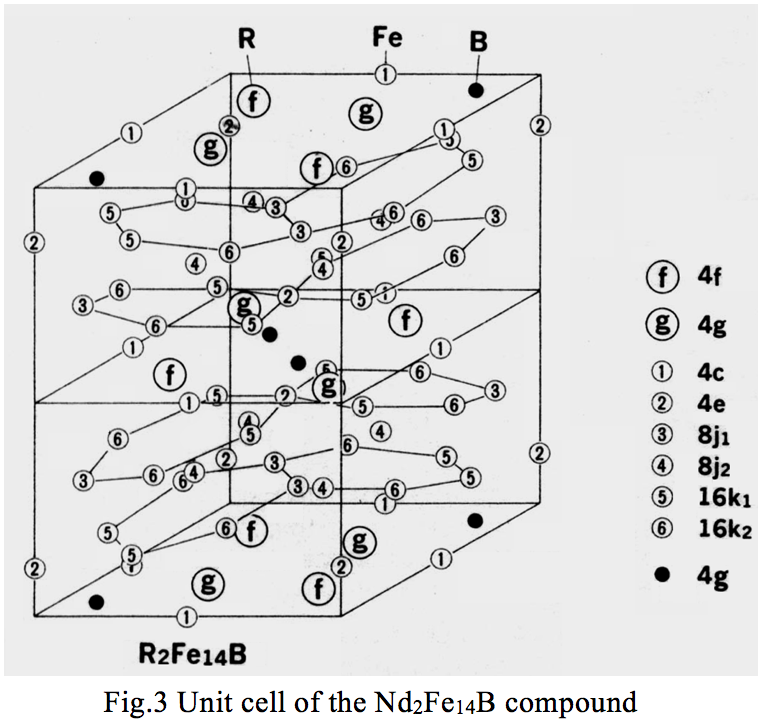
15 What is the Nd-rich phase, what does it mean?
Besides the main phase Nd2Fe14B, another important phase in Nd-Fe-B magnet is the Nd-rich phase. The composition and structure of the Nd-rich phase are very complicated withThe content of Nd range from 55% to 95%, and its crystal structure can be fcc (face center cube), dhcp (double six square) or amorphous state with regard to the composition and process of magnet alloy. the composition and structure of the Nd-rich phase in ingot are different from that of the sintered magnets or the annealed magnets. The existence of Nd-rich phase is an important source for the high coercivity of large block Nd-Fe-B magnets. It is important for researchers to investigate the control of Nd-rich phase.
The domain wall in magnet without Nd-rich-Phase can move easily during the process of magnetization or reverse magnetization. On the macroscopic view, the magnets are easily magnetized or demagnetized, and the coercivity of the Nd-Fe-B magnets is very low. If the main phase Nd2Fe14B is surrounded by a non-magnetic Nd-rich phase,The movement of domain wall inside the magnets is limited to a single grain during the magnetization or demagnetization process. On the macroscopic view, the Nd-Fe-B magnets are more difficult to be magnetized or demagnetized, and the coercivity is higher.
The oxygen in the Nd-Fe-B magnet is mainly concentrated in the Nd-rich phase, which destroys the Nd-rich segregation to the main phase Nd2Fe14B grain, so oxygen has a great influence on the coercivity of Nd-Fe-B magnet. In addition, oxygen plays an important role in the eutectic behavior of the Nd-rich phase and the boundary characteristic between the Nd-rich phase and the main phase after sintering.
16 What is the fabricating process routine of sintered Nd-Fe-B permanent magnet?
The sintered Nd-Fe-B magnets are usually formed by powder metallurgical processes. The general fabricating process routine is as follow:
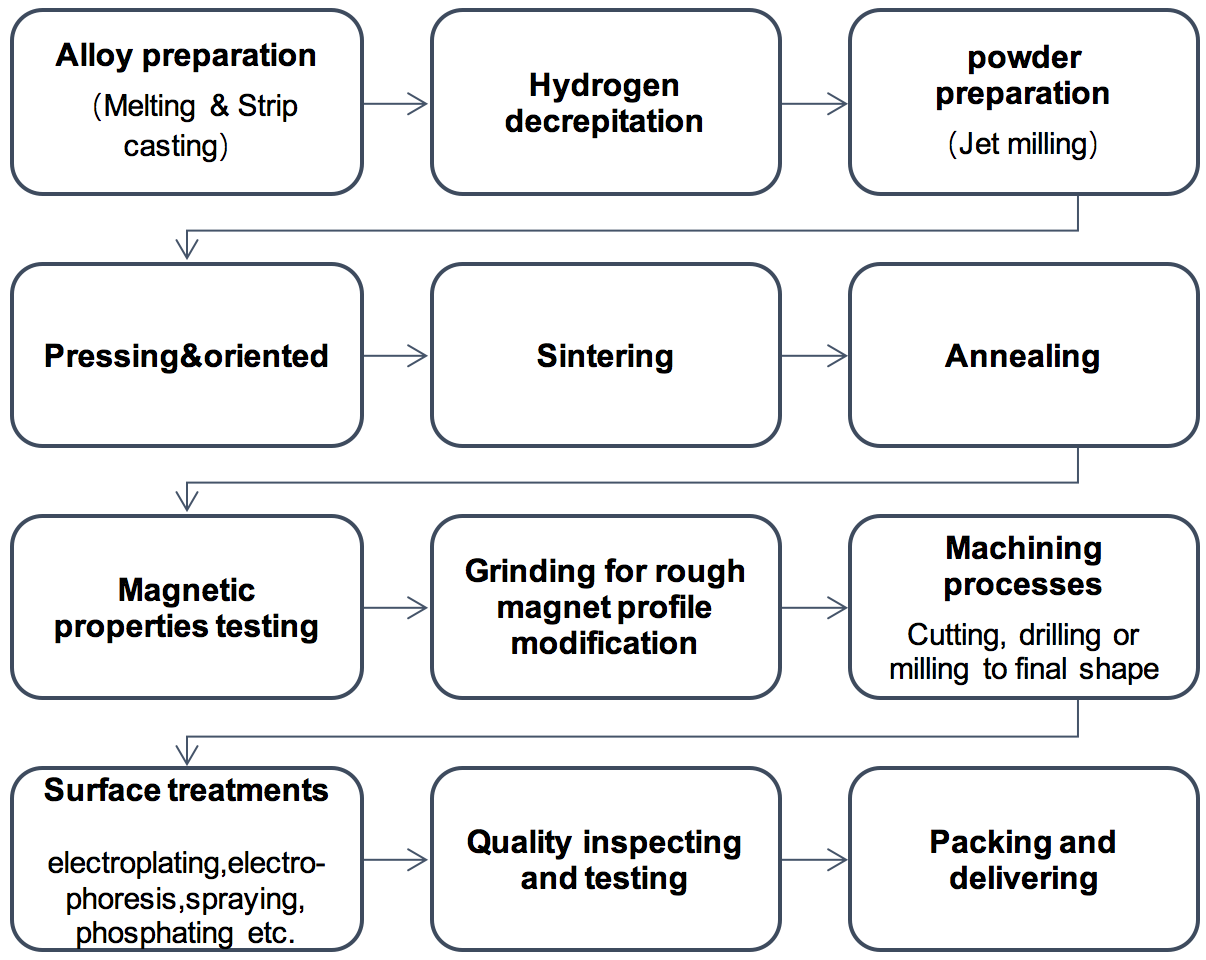
17 What is grain boundary diffusion process (‘GBDP’)? And what is the main features of the magnet with GBDP?
Generally speaking, grain boundary diffusion process (GBDP) means that the heavy rare earth, including Dy or Tb, is introduced on the surfaces of the sintered or annealed magnet, and then diffuses into the magnet through grain boundary by heat treatment, so that intrinsic coercivity can be enhanced drastically. Compared with conventional alloy addition, the heavy rare earth elements by GBDP are distributed on the surface of main phase grains forming a high anisotropy layer and enhancing the coercivity more effectively without significant reduction of remanence and maximum energy product. Therefore, plenty of heavy rare earth can be saved with this GBDP method to achieve same coercivity.
As the original magnet in the GBDP, one dimension of the magnet s should always be limited. the main features of GBDP magnets is that the concentration of diffused elements from surface to center decrease gradually. There is similar gradient distribution of the heavy rare earth in the main phase grain from surface to center, especially the main phase grain close to surface of the magnet.
18 How about the mechanical properties of sintered Nd-Fe-B magnets?
The typical mechanical properties of sintered Nd-Fe-B magnets are as follows.

Obviously, sintered Nd-Fe-B magnet is the typical brittle material. During the machining, assembling and application of the magnet, attention should be paid to preventing the magnet from being subjected to severe impacts, collisions, and excessive tensile stresses which may result in cracking or chipping of the magnet.
Noting that sintered Nd-Fe-B magnets often have strong magnetic force, personal safety must be considered carefully when handing magnetized magnets. corresponding assembly tools must be equipped in advance Especially for magnetized magnets with large dimension,to prevent fingers from being pinched by strong attraction force between magnets.
19 How about the machining process of sintered Nd-Fe-B magnets?
machining process of sintered Nd-Fe-B magnets:
Magnetblocks——Profile modification——Cutting——Fine grinding——Chamfering——Coating——Inspections——Finished products
Profile modification of magnets is usually carried out by centerless grinder for cylindrical magnet and plane grinder for rectangle magnet, so that magnet blocks can achieve regular external profile and specified dimension.
The cutting process is usually employed for final shape machining by inner diameter diamond slicer, wire cutter or wire saw.
Fine grinding process is usually carried out for final dimension and geometric tolerances by using plane grinder, double-side grinder ,etc.
Edge chamfering is a pre-treatment step before electroplating to decrease the thickness deviation of coating layer due to the relatively concentrated current density in edges during the electroplating process. Since the conventional finished products are small in size and varied in shape, vibratory tumbling technology is most suitable for chamfering of the product in mass production. Vibratory tumbling equipment, with high production efficiency and high chamfering speed, has been widely used for sintered Nd-Fe-B magnets.
Plating/coating is employed to form a protective layer on magnet, barrel plating iswidely used in electroplating process , while rack plating is often used For large magnets. coating types for sintered Nd-Fe-B magnet, such as Ni plating, Zn plating, alloy plating and composite plating, are chosen based on the application environment and appearance requirements of products.
In addition to electroplating, sintered Nd-Fe-B magnets can also be coated by physical vapor deposition (PVD) method which includes evaporation, sputtering, and ionization with coating layers such as Al, Zn and Cr. Chemical vapor deposition (CVD) can form nitrides or carbide coatings of Ti, Cr. Besides, the surface protection of sintered Nd-Fe-B magnet can also be achieved by chemical passivation, electroless plating, paint bathing, thermal powder spraying, epoxy coating and so on.
20 How about the plating process of sintered Nd-Fe-B magnets?
The plating process of sintered Nd-Fe-B magnets can be roughly divided into the following three stages.
Pre-plating surface treatment
The magnet should be degreased, cleaned, etched (activated), recleaned, etc. The surface of magnet before plating, which has a direct effect on the coating quality of products, needs to be free of oil, dirt and rust.
Plating
After surface treatment, the plating quality mainly relys on the solution chemicals and plating conditions. Therefore, technical specifications should be satisfied strictly, including chemical compositions, additive contents, working temperature and current density.the plating time shoulde be controlled according to the coating thickness requirements and the deposition rate.
Post-plating treatment
Post-plating treatment is also an important process step for plating. For example, magnets after plating are further subjected to neutralization treatment and cleaning in general. Sometimes, gloss treatment (lighting), passivation and organic coating are also needed to meet the special requirements of product.
21 What are the inspection items for semi-finished and finished sintered Nd-Fe-B permanent magnet?
Inspection for semi-finished sintered Nd-Fe-B magnets mainly includes dimension, geometric tolerance inspection. The details are as follows.
Dimension Inspection——Length, width, thickness, outer diameter, inner diameter, arc angle, etc.
Geometric tolerance Inspection——Parallelism, roundness, perpendicularity, surface roughness, profile tolerance, corner/edge radii, etc.
Inspection for final products mainly includes six aspects: dimension, geometric tolerance, magnetic performance, reliability test, coating, surface adhesiveness and appearance. The details are as follows.
Dimension, geometric tolerance Inspection——Length, width, thickness, outer diameter, inner diameter, arc angle, parallelism, roundness, perpendicularity, surface roughness, profile tolerance, corner/edge radii, etc.
Magnetic Performance Inspection——magnetic properties at room temperature such as magnetic moment, magnetic angle deviation, surface field distribution, etc.
Reliability Test——high temperature flux loss, corrosion resistance ( Pressure Cooker Test , Humidity Test, Salt Spray Test, Weight Loss Test, etc.
Coating Inspection——thickness of coating, hardness, coating adhesiveness, etc.
Surface Adhesiveness Inspection——surface tension, bonding strength for magnets assembly, etc.
Appearance Inspection——sorting of surface imperfections such as cracks, pin-hole, and chips, etc.
The items mentioned above are conventional inspection for semi-finished and Finished Products. They can be adjusted according to customer’s requirements.
22 What are the manufacturing process of bonded Nd-Fe-B permanent magnets?
Bonded Nd-Fe-B magnets are prepared by magnetic powder compounded with polymer binders (rubber, plastic or resin) and other additives in a certain proportion. According to the development history of the quenched Nd-Fe-B magnet technology, bonded Nd-Fe-B magnet is also called ‘MQ-I magnet’. There are four techniques that are currently used to produce bonded Nd-Fe-B magnets, which include compression molding, injection molding, extrusion, and calendaring. The first two are the most commonly employed techniques.
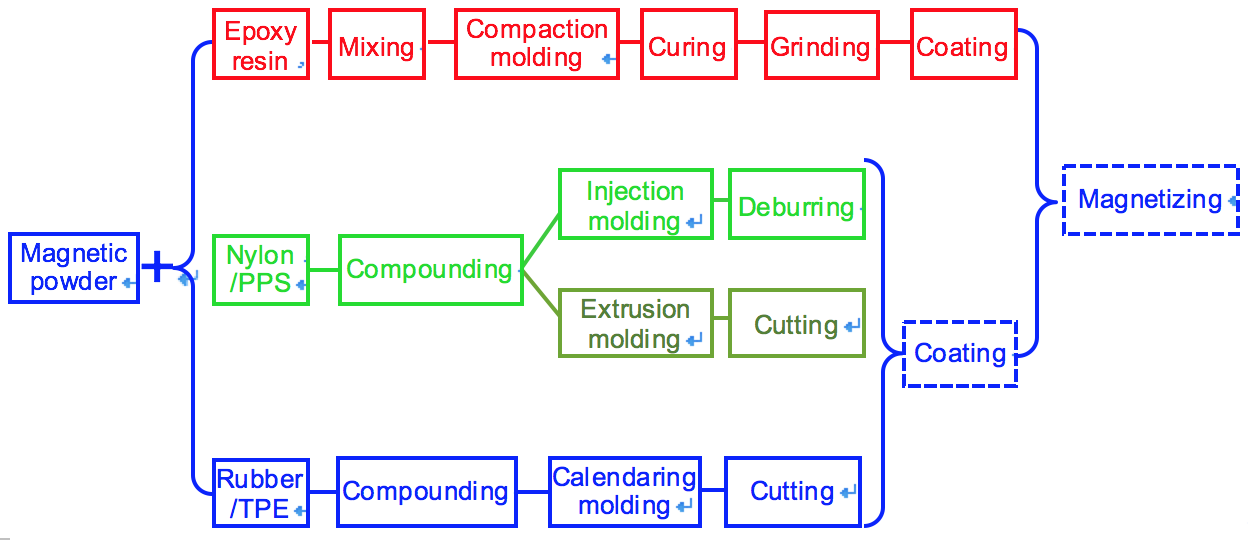
Fig.4 The Manufacturing Process of bonded Nd-Fe-B Permanent Magnet
23 What?features?do bonded Nd-Fe-B permanent magnets?have?
Compression Molded Magnets
In compression molded magnets, the Nd-Fe-B magnetic powder is mixed with the smallest portion of resin: the best compression molded magnets have a density of 6.4 g/cm3. The principal advantage of compression molding is the highest productivity, together with the relatively poor density uniformity along the pressing direction. oxidation may occur rapidly when Bonded Nd-Fe-B magnets are exposed to moisture. Therefore, all compression molded magnets must be coated prior to application. thin-walled, ring-shaped magnets are predominant in a variety of spindle and stepping motors.
Injection Molded Magnets
The primary advantage of injection molding process is that net-shaped parts with complex shapes and tight tolerances can be achieved in mass production. Another feature of injection molding is that it can be integrally formed into components with other metal or plastic parts, resulting in a considerable saving in assembly costs. The injection molded magnets have higher mechanical strength but lower magnetic properties than the compression molded ones. Because the magnets have a higher volume portion of binder, coating is not necessary for most applications.
Extrusion Molded Magnets
Extrusion Molded Magnets have higher magnetic properties than injection molded magnets because of less resin content. Extruded magnets have lower porosity and better corrosion resistance than compression molded ones. For certain applications coating is unnecessary. Magnets of over 1 meter in length can be achieved, and one set of extrusion mold can make products of different lengths. Magnets of same dimensions along the length can be continuously extruded with propertiesof nearly no deviation.
Calendaring Molded Magnets
Calendaring is a rolling process for making continuous flexible sheets, which have lowermagnetic propertiesthan injection molded magnets because of lower volume ratio of magnetic powder. Calendaring Molded Magnets can be made into strips, rolls, large area sheets and so on. various machining processes such as punching, bending and cutting are available. The application for Calendaring Molded Magnets include a variety of motors, sensors, and holding devices.
24 What is a hot pressed / hot deformed magnet?
The quenched Nd-Fe-B powder in certain particle size range obtained by over-quenching or optimal quenching speed is subjected to hot pressing / deformation under a protective atmosphere or under vacuum at 700℃ to 800℃. the obtained fully densed nanocrystalline isotropic magnet is called hot pressing magnet. According to the development history of the quenched Nd-Fe-B magnet technology, this magnet is named as ‘MQ-II magnet’.
Based on the basic principle that the easy magnetization axis of NdFeB grains will align to the deformation direction during the hot deformation process, anisotropic magnet is obtained by large deformation under vacuum or protective atmosphere. The obtained anisotropic full-density neodymium iron boron magnet is called hot-deformed magnet, which is also named ‘MQ-III magnet’ according to its sequence in history.
25 What are the amorphous/ nanocrystalline soft magnetic materials?
Iron-based amorphous soft magnetic ribbon was produced by rapid quenching at 106℃/s from liquid metal consisting of Fe, Si, B and small amount of Cu and Nb additives. The atomic structures of Amorphous alloy is random, while Extremely small and uniform, nano-crystalline(~10nm) grains may obtained by heat treatment of this ribbon above the crystallization temperature. This nano-crystalline structure leads to superior soft magnetic properties than amorphous alloys. Amorphous and nanocrystalline soft magnetic materials are characterized with high permeability, high magnetic induction, low coercivity,low power loss, excellent performance over wide frequency and excellent temperature stability, which are known as new energy-saving materials in the 21st century. They are widely used in IT and power electronics industry. They promote the high-frequency, miniaturization trends of electronic products subject to environment protection and energy saving.
26 What is magnetic field lines and what are its features?
The magnetic field line is defined as a line which is paralell to the magnetic induction at any point. The magnitude of magnetic inductionparallel to is proportional to the density of the magnetic field line. Understanding the basic characteristics of magnetic field line is the basic of analyzing magnetic circuit.
Both theory and practice show that magnetic field line has the following basic characteristics:
The magnetic field lines always start from the N pole,terminate on the adjacent S pole, and form a closed loop. This phenomenon is called magnetic flux continuity theorem in electromagnetism, and is described by Maxwell equation as:
▽·B=0 (4)
The above equation is also called Gauss’s law of magnetic field which means that the divergence of any magnetic field is zero, that is, the total magnetic flux through any closed surface is equal to zero, and the magnetic field line is always a closed loop.
Similar to the current, the magnetic field line always takes the path with the minimum magnetic resistance (the maximum magnetic permeability), therefore the magnetic flux line is usually a straight line or smooth curve, and there is no magnetic field line that bends at right angle.
A magnetic field line can never cross another field line. Any two of them of the same direction will expel each other.
The magnetic field lines are always perpendicular to the polar surface of ferromagnetic materials when ferromagnetic materials are not saturated. When ferromagnetic materials are saturated, the magnetic field lines within ferromagnetic materials behave the same as non-ferromagnetic medium(such as air, aluminum, copper, etc.).
Due to the above characteristics, the magnetization of the medium depends on the magnetic properties and geometric shapes of the medium. In general, the medium is in the state of inhomogeneous magnetization, which means that the magnetic lines inside the medium are usually not parallel lines, but in curves unevenly distributed. In addition, there is electric insulator in nature, but there is no magnetic insulator. And the difference of materials in magnetic permeability is less than the difference in electric conductivity, which leads tonormal magnetic flux leakage in magnetic circuit. The phomenon of the existing inhomogeneous magnetization and normal flux leakage makes the accurate calculation of magnetic circuit very complicated.
27 What is magnetic circuit? What are the open circuit state and closed circuit state in the magnetic circuit?
Magnetic circuit refers to the component which is composed by one or more permanent magnets, current-carrying wires and soft magnets in a certain dimension with a specific air gap. Soft magnets can be pure iron, low carbon steel, Fe-Si alloy, Ni-Fe alloy, Ni-Co alloy and other materials with high magnetic permeability. Soft magnets, known as yoke iron , plays the role in controlling the direction of magnetic flux, increasing local magnetic induction, preventing or reducing magnetic flux leakage, and enhancing the mechanical strength of the entire component.
The state of a single magnet without soft magnets is usually called open circuit state. When a permanent magnet is in a magnetic circuit with soft magnets, it is in the closed circuit state。It is worth noticing that this title is different from the true closed state in which there is no air gap and the permanent magnet does not provide external magnetic field .
28 What is Ampere’s law?
The relationship between the magnetic field strength H and the current density J in Maxwell’s equation is:
▽×H=J (5)
Its integral form is:

It means that the line integral of the magnetic field H along any loop is equal to the integral of current in any surface bounded by that loop, which is known as the Ampere’s Law. Ampere’s Law and flux continuity theorem are two basic equations for solving all magnetic circuit problems.
It takes more than 2000 years from the discovery of natural magnets attract iron and can be used as a compass for navigation, to the discovery of relationship between electricity and magnetism in 1820. Around 1825, Ampere and Ohm proposed their epochal laws respectively. In the same year, William Sturgeon made the first electromagnet in human history. In 1830, Michael Faraday and Joseph Henry discovered electromagnetic induction. In 1832, William Sturgeon invented the rotary electromagnetic engine. In 1856, Werner Siemens of Germany invented the epoch-making motor. In 1873, J.C. Maxwell of the Royal Academy of sciences in London, expressed the complete laws of electricity and magnetism, in systematic and accurate mathematical form, the Maxwell equation. At this point, the theory of electromagnetism is basically mature. Maxwell’s equation embodies the contributions of many outstanding scientists worthy of eternal remembrance from 1820 to 1860. They are: Coulomb, Ampere, Faraday, Gauss, Weber, Helmholtz, Henry, Joule, Lenz, Poisson, Maxwell, Lorentz, Biot and so on.
29 How does the design and calculation of the magnetic circuit generally be carried out? How to select the properties of the magnet according to the magnetic circuit?
Usually, there are two methods for magnetic circuit design and calculation. one is based on parameter analysis according to the magnetic circuit theory , the other is the finite element method based on modern electromagnetic field theory. The accuracy obtained by the former method is poor for many magnetic applications, While the latter method can obtain accuracy above 10-3
and has been used widely with the popularization of computer technology.
In the case of small air gap (Lg/Dm< 0.15, Lg for gap spacing, Dm for magnet diameter or short edge length), soft magnetic materials with high Bs such as Fe-Co alloy or mild steel should be selected and settled in front of the magnet to improve the magnetic field in air gap; in the case of medium gap (0.15 < Lg/Dm< 0.5), magnets with high Br is preferred; in the case of big gap (Lg/Dm> 0.5), magnets with high HcJ is preferred.
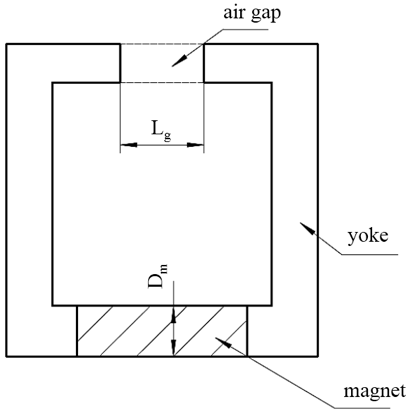
Fig.5Magnetic circuit diagram
